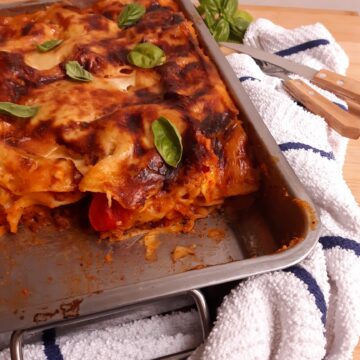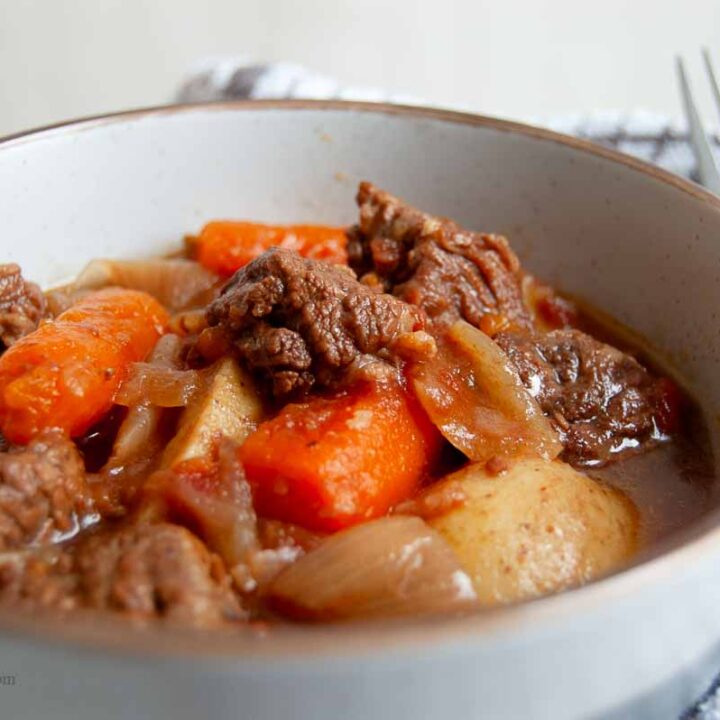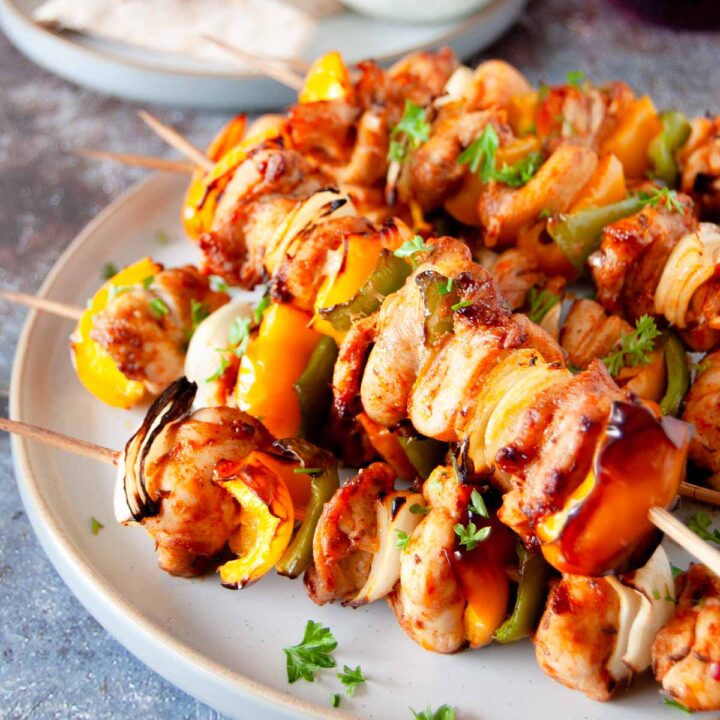Hello my friends! Today, I'd like to share with you my recipe for lasagne.
It's my favourite meal when I want something nice, hearty and comforting. It's also great for batch cooking - a roaster filled with lasagne easily feeds up to six people!
There is this feeling of comfort and happiness when you eat it!
My first lasagne came from Rome
I made my first lasagne after I bought a pack of this Italian dried pasta in Rome, during my holiday there (this was around Easter 2011).
I remember buying the pasta in a small corner shop, and having a short conversation with a local man who saw me getting it. He was trying to explain to me how to cook it.
Unfortunately, he only spoke Italian and I did not understand him a single word. I did guess it might have had something to do with the instruction 'no need to pre-boil'. I was only nodding and doing 'aha, ah' and when it seemed that he finished with the explanation, I said a few times 'Grazie' as politely as I could, and left the shop.
Whilst I was feeling guilty for not being able to speak to this kind gentleman, I also felt proud, as the pack of pasta was the best souvenir - and one which created such lovely memory that hopefully stays in my head forever!
Once we got back home, I made my first ever lasagne dish. And we all loved it.
Since then, my cooking of it has improved and this final version has been proven over the years.
It is a dish that my mum asks me to cook when I am at home, but I also cook it for them when they visit me here, in London. The great news is, my boyfriend loves it too!
That being said, it may be one of my signature dishes!

Let's take a look at the recipe:
What do you need to make lasagne?
I usually make lasagne from minced beef, but you can substitute it in this recipe for minced pork or turkey - I've tried both, and both work. Just remember to add some sunflower or vegetable oil if using lean (low fat) meat, otherwise it would be too dry.
Lasagne can be stretched by using various vegetables. I tend to swap them around according to what I have at home, but the basics remain the same: onion, garlic, tomatoes (fresh and/or canned), carrots and celery sticks.
Recently, I've run out of onions and celery, but I had some frozen leek and used it instead of the two - it worked well, so feel free to improvise if you need to!
Sometimes I also add courgette (zucchini), aubergine (egg plant) or chunky mushrooms.
The most important thing about lasagne is, to have enough liquid in the dish - to make sure the pasta fully cooks and that the sauces don't dry out or, and that it doesn't burn in the oven.
There are two sauces in lasagne
One with tomatoes and meat (Bolognese sauce), and another based on milk and flour (called bechamel).
Bechamel sauce is easy to make, but you need to give it enough attention, as it also likes to burn easily from the bottom of a pan.
I am using dried lasagne sheets in this recipe. If you're going to use fresh ones, don't forget to adjust the cooking time according to the packet!
Also, if you have some fresh herbs, feel free to use them instead of the dried ones.
As you can see in my notes below, there is some preparation time required before it can be put in the oven, however, I can honestly tell you that this meal is totally worth every effort!
Shop-bought lasagne are never even close enough to homemade ones.
Can you freeze this lasagne?
This lasagne will stay fresh in the fridge for up to two days. Leave to cool down, cover with a lid or aluminum foil and put in the fridge.
They can also be frozen. Store in an airtight container in your freezer for up to two months.
Enjoy cooking them and Boun appetito!
📖 The Recipe

Lasagne with Bolognese sauce
Ingredients
For the Bolognese sauce:
- 500 g minced beef, 20% fat, chilled
- 1 onion, chopped
- 2 celery sticks, finely chopped
- 3 cloves garlic, finely chopped
- 2 large carrots, peeled and diced (dices about 0.5-1cm small)
- 2 tablespoon tomato puree
- 1 teaspoon dried thyme
- 1 teaspoon dried oregano
- 2 stems fresh rosemary
- 1 handful fresh basil, leaves only
- 2 x400g cans chopped or plum tomatoes, or 12 fresh salad tomatoes, chopped
- salt and black pepper, to taste
For bechamel (white) sauce
- 50 g unsalted butter
- 1.2 l semi-skimmed milk, chilled
- 2 tablespoon plain flour
- ¼ teaspoon ground nutmeg
- salt and black pepper, to taste
For the layers
- 500 g dried lasagne sheets
- 150 g cheddar cheese, grated
- 75 g Grana Padano or Parmesan cheese, grated
- 2 tablespoon sunflower oil, for greasing the roasting dish
For serving (Optional)
- wild rocket leaves
Instructions
- Heat up a large non-stick frying pan on high heat (I like to use wok). When hot, add the minced meat. Break the meat up into small parts with a wooden spoon. Cook for about 10mins or until brown, stir occasionally.
- In the meantime, wash and cut the vegetables.
- Once the meat is browned, season it with thyme, oregano, and rosemary. Add a pinch of salt and black pepper.
- Add the chopped onion, garlic, celery and tomato puree, stir and cook for 3mins.
- Add the diced carrot and toss. Lower the heat to medium-high heat and cover with a lid. Cook for 10mins.
- In the meantime, prepare the bechamel sauce: Melt the butter in a sauce pan on medium heat. Once fully melted, add the flour and whisk together until you get a smooth batter. Fry for a minute or two and then start gradually adding the milk. Keep whisking so it's smooth and so that it doesn't burn from the bottom of the pan. It will slowly become thicker. Season with nutmeg, salt and pepper. Turn off the heat when thick and smooth.
- Check on the Bolognese sauce. When the carrots are almost soft, add the canned tomatoes. Using one of the empty tins, fill it up to ⅔ with cold tap water. Add the water to the meaty sauce. Add basil leaves, stir thoroughly, cover and cook for another 5mins. Turn off the heat.
- Preheat the oven to 200C/180C fan.
- Grate both of the cheeses, mix them together and set aside.
- Prepare the baking dish - you can make this into one big one (roasting dish) or into 4 to 6 small ones, depending on their size (in this case, you'll have to repeat the following steps for each of them): Grease the bottom and sides of the dish with sunflower oil, using a brush or paper towel.
- Lay down one layer of dried lasagne sheets. Pour over some bechamel sauce, so the pasta is fully covered by it. Top with 2-3 large spoonfuls of the Bolognese sauce. Spread it out evenly. Sprinkle with a handful of grated cheese. Repeat this step until you use all of the Bolognese sauce (it is enough for 3-4 layers). There should still be some bechamel sauce left.
- The last (top) layer will be made of lasagne sheets and remaining bechamel sauce. Sprinkle with grated cheese and place in the oven.
- Bake for 35 mins or until bubbling, soft and golden.
- Serve with wild rocket salad and enjoy!


















Gilly
Hello CountryGirl! I love your recipes. I also make lasagne, but because my son’s a vegetarian I susbstitute the meat with brown lentils and cook it in the same way as the bolognese sauce, using olive oil and also adding a glug of red wine and a clove to the mix. I then pressurise the sauce for about 40 minutes (first making sure there’s enough liquid so it doesn’t burn, or adding more water and tomato paste if necessary). The results are also delicious, as well as being nutritious. Thank you for sharing your recipes!
Country Girl in London
Hello Gilly, thank you very much, it means a lot! 🙂
Your vegetarian version sounds great, thank you for sharing it! I have never tried it with lentils before, but I think I should give it a go next time! Have a nice weekend xx